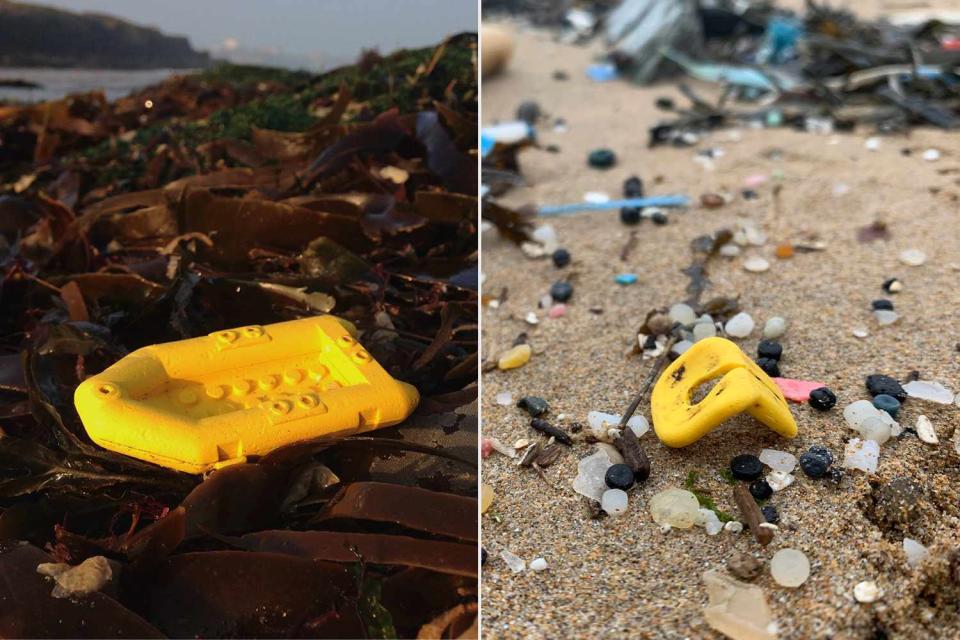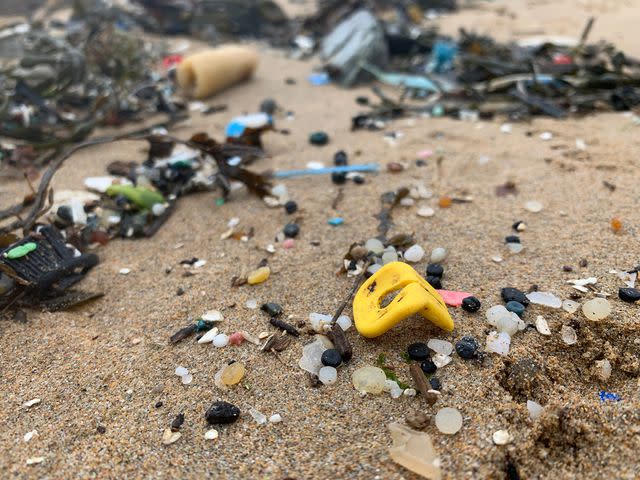Why Are Thousands of Lego Pieces Washing Up on Beaches? The Answer Lies in a 1997 Cargo Ship Spill (Exclusive)
Tracey Williams tells PEOPLE how the Lego Lost at Sea project got started

Tracey Williams/Lego Lost At Sea
Lego life raft washed up in seaweed (left), Lego life vest on shoreA 1997 cargo ship crash led to nearly 5 million individual Lego pieces lost at sea
In the years since, beachcombers have kept an eye out for these pieces, including Tracey Williams
Williams tells PEOPLE about her experience learning more about the ecological dangers of plastics at sea while also tracking the discovery of these Lego pieces
Beachcombers find all kinds of surprises washed ashore — and in select areas of the U.K., among the seashells and marine life is a different kind of "treasure": Legos.
In 1997 near the tourist attraction Land's End in the Cornwall area of England, a cargo ship called the Tokio Express was struck by a rogue wave. The ship lost several of its enormous containers, one of which was full of nearly 5 million individual Lego pieces, which were being transported from the company factory in Denmark to North America for distribution and sale.
Coincidentally, the pieces were being sent to assemble Lego Pirates and Lego Aquazone sets, among others. As a result, a vast number of aquatically themed Lego pieces have been lost at sea and found in the years since.
Tracey Williams has documented the discovery of these pieces across social media as part of a larger research project she has been engaged in for several years. Her account, LegoLostAtSea, shares updates as pieces are found, with many traveling far beyond the English Channel and the Celtic Sea.
Never miss a story — sign up for PEOPLE's free daily newsletter to stay up-to-date on the best of what PEOPLE has to offer, from juicy celebrity news to compelling human interest stories.
Wow. Two days after 13-year-old Liutauras found a Lego octopus from the Great Lego Spill of 1997 on the shores of the ancient Cornish market town of Marazion, Justin Goode found another, this time 10 miles further round the coast at Porthleven. Like double decker buses, none for… pic.twitter.com/up0U2TWQsW
— Lego Lost At Sea (@LegoLostAtSea) April 14, 2024
Related: 'Millions' of Jellyfish-Like Creatures Set to Wash Up on California Beaches
"About 40 years ago, my parents moved to an old house perched on the clifftop on the south coast of Devon, the neighboring county to Cornwall," Williams tells PEOPLE. "We’d often go beach combing on the shores beneath the house, and in 1997, we started finding Legos washed up, much of it sea-themed — tiny flippers and spearguns, cutlasses and life jackets — and, if you were really lucky, a dragon or an octopus.
"My children would fill their tiny buckets with ‘treasure’ and we’d lug them up the coastal path to my parents’ house, which was called The Eyrie or eagle’s nest, perched high on the clifftop overlooking the sea. We knew the Legos were from a cargo spill, as there was just so much of it, but it wasn’t until much later that I began to dive deeper into the story."
Williams herself moved to Cornwall in 2010 and found a Lego piece on her first beach trip after the move.
"I was quite astonished that it was still appearing after all this time, so I started to research the story in more detail. I'd become part of a beach clean network, so I set up a Facebook page to see if I could find out who else had found Lego from the spill, where they’d found it and which pieces they’d discovered."
The project took off after a BBC journalist covered the effort, "and then people from all around the world started to get in touch."
Not only did Williams get in touch with others interested in marine environments, but she's also been able to connect with experts.
"We teamed up with scientists at the University of Plymouth to see if they could discover how long Lego bricks would last in the sea and sand. Their experiments revealed the Lego would persist for anywhere between 100 and 1,300 years," she says.
"The bricks they tested weren’t from the spill, but classic-style Lego bricks picked up during beach cleans."
Her effort to document the findings has spread from Facebook to Twitter, Instagram and other social networks. She encourages those who make finds to share them with her and her audience.
Williams has also authored Adrift: The Curious Tale of the Lego Lost at Sea, sharing with readers the "sobering tale" of plastic's life in the ocean.
"There are so many different threads and angles to the story, and I’m grateful to all the oceanographers, maritime archaeologists, marine biologists, paleontologists and environmental scientists who have shared their knowledge. I wanted to capture what we had discovered along the way, and a book seemed like the perfect vehicle," she says.
"There is talk of a documentary, too. The Lego spill has given us a chance to talk about plastic in the ocean in a way that everyone can understand and identify with."

Tracey Williams/Lego Lost At Sea
Lego pieces washing up on the beachWilliams notes that the project is perceived as "part whimsical, part doom-laden — and I think that's very true."
"To me, it’s like a five-million-piece jigsaw puzzle with millions of pieces still to find."
"Some of the plastic we pick up from beaches is decades old — in some cases 60-70 years old — toothbrushes, cereal packet toys, the remains of old footballs, plastic shoes from the '60s. It shows how long plastic lasts in the coastal environment, some buried in sand, some lying on the seabed. I’m intrigued and disturbed by the changing nature of beachcombing — how once we searched for shells and sea glass and how we now pick up plastic."
Many are surprised by what "good condition" the 17-year-old pieces are in when they're found, she says.
"Some of the little Lego door frames and life rafts even have cup corals growing on them," she notes.
As for her most unique finds, Williams says, "dragons and octopuses are always a favorite find, as are the little yellow life rafts. I do like to find a cutlass as they’re so difficult to spot.
"But my favorite piece of all must be the tiny Lego Crisis News Crewman, not found by me but hauled up in a fisherman’s net 20 miles offshore. There were 59,500 of these in the shipping container, but this is the only one we’ve ever seen. The rest are thought to be still lying on the seabed."
Williams also loves "the tiny CB radios. These were only produced in 1997, and although 13,300 were lost overboard, very few have been found. I often wonder if the tiny Lego crisis news crew personnel being transported in the shipping container used them to radio for help as they plummeted into the abyss."
In 2023, the Lego Lost At Sea project was named Rescue Project of the Year in the Current Archaeology awards. The project continues, with a scientific paper on the horizon as Williams encourages beachcombers to share their discoveries if they find a piece of Lego that washes up.
For more People news, make sure to sign up for our newsletter!
Read the original article on People.


